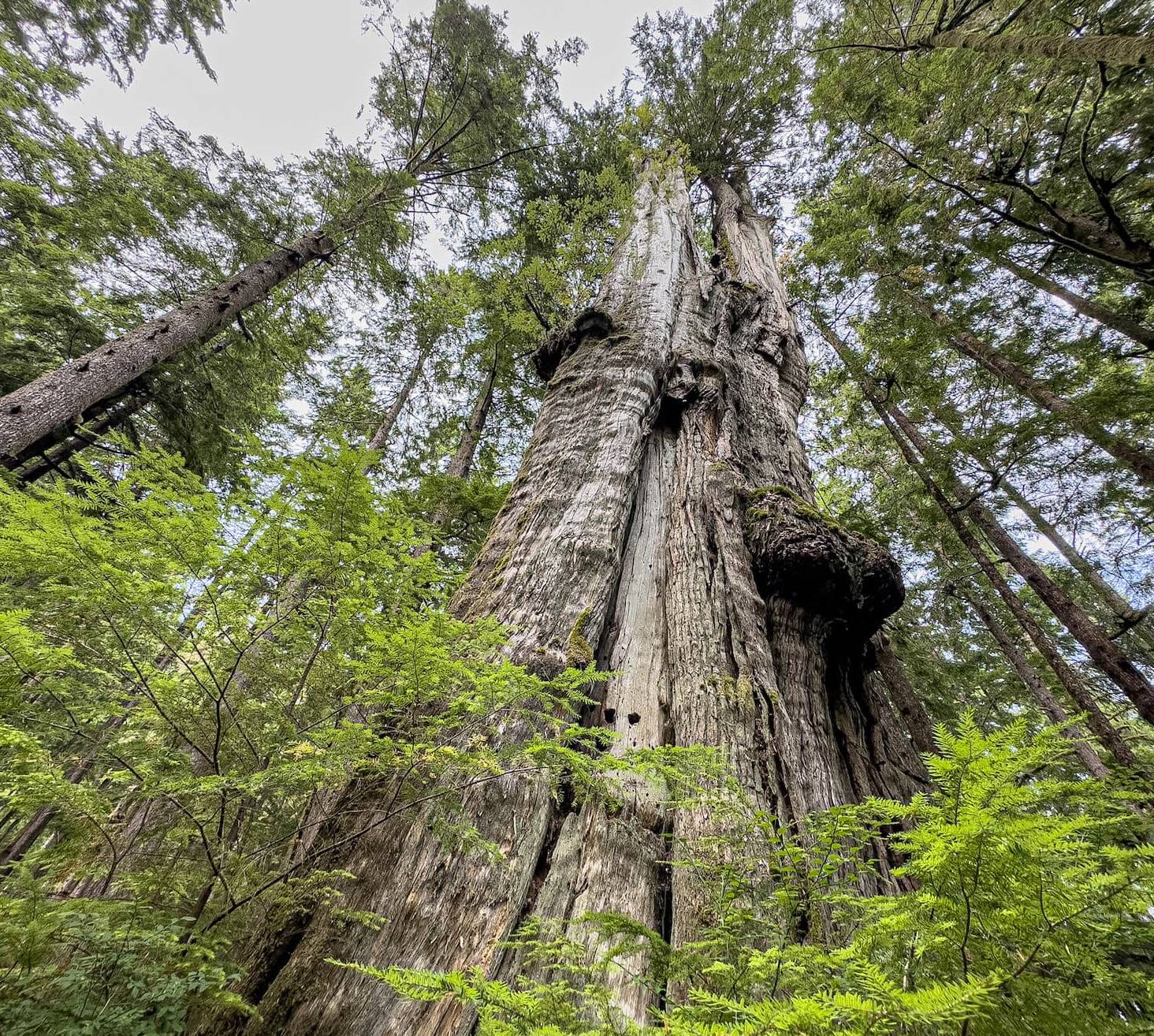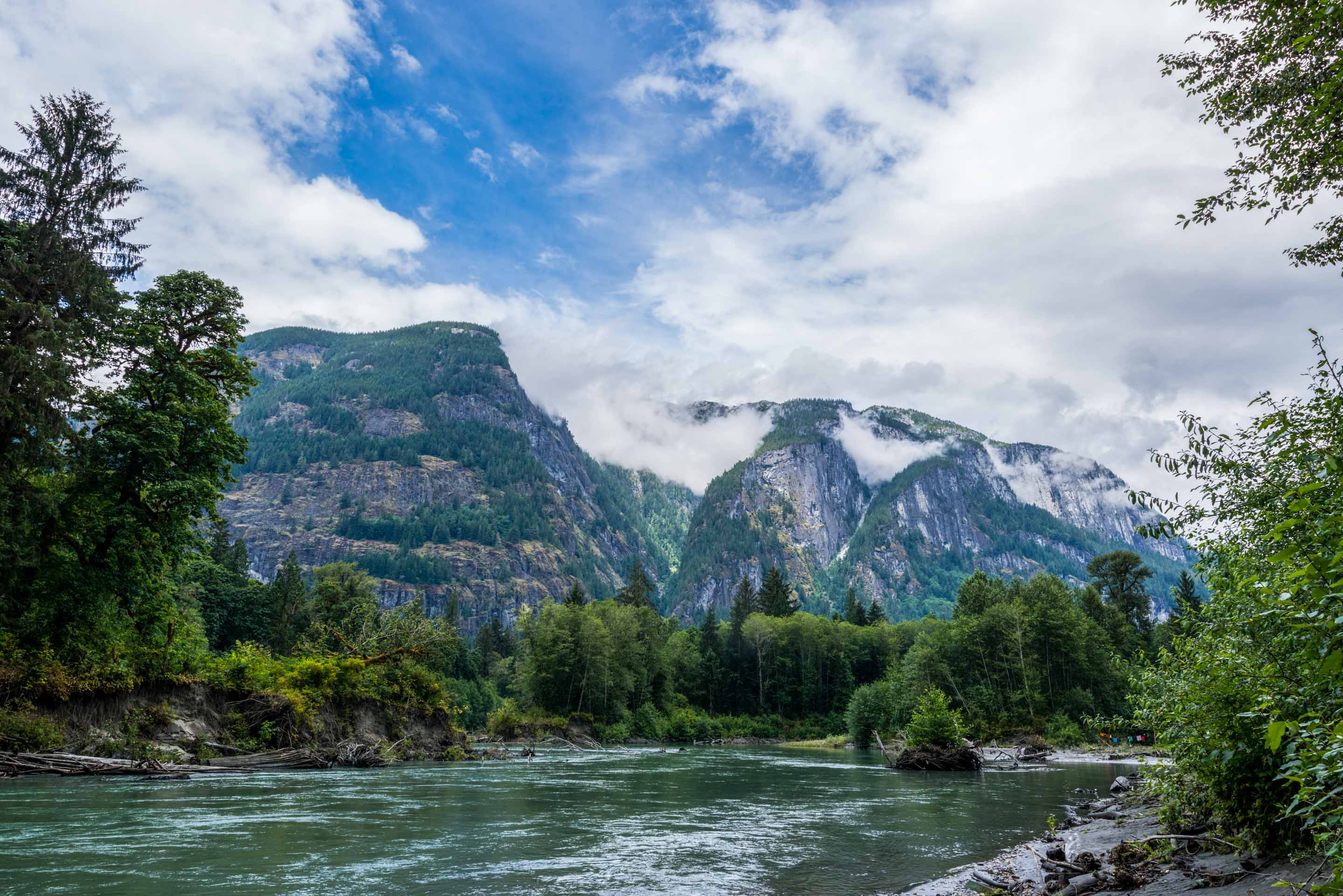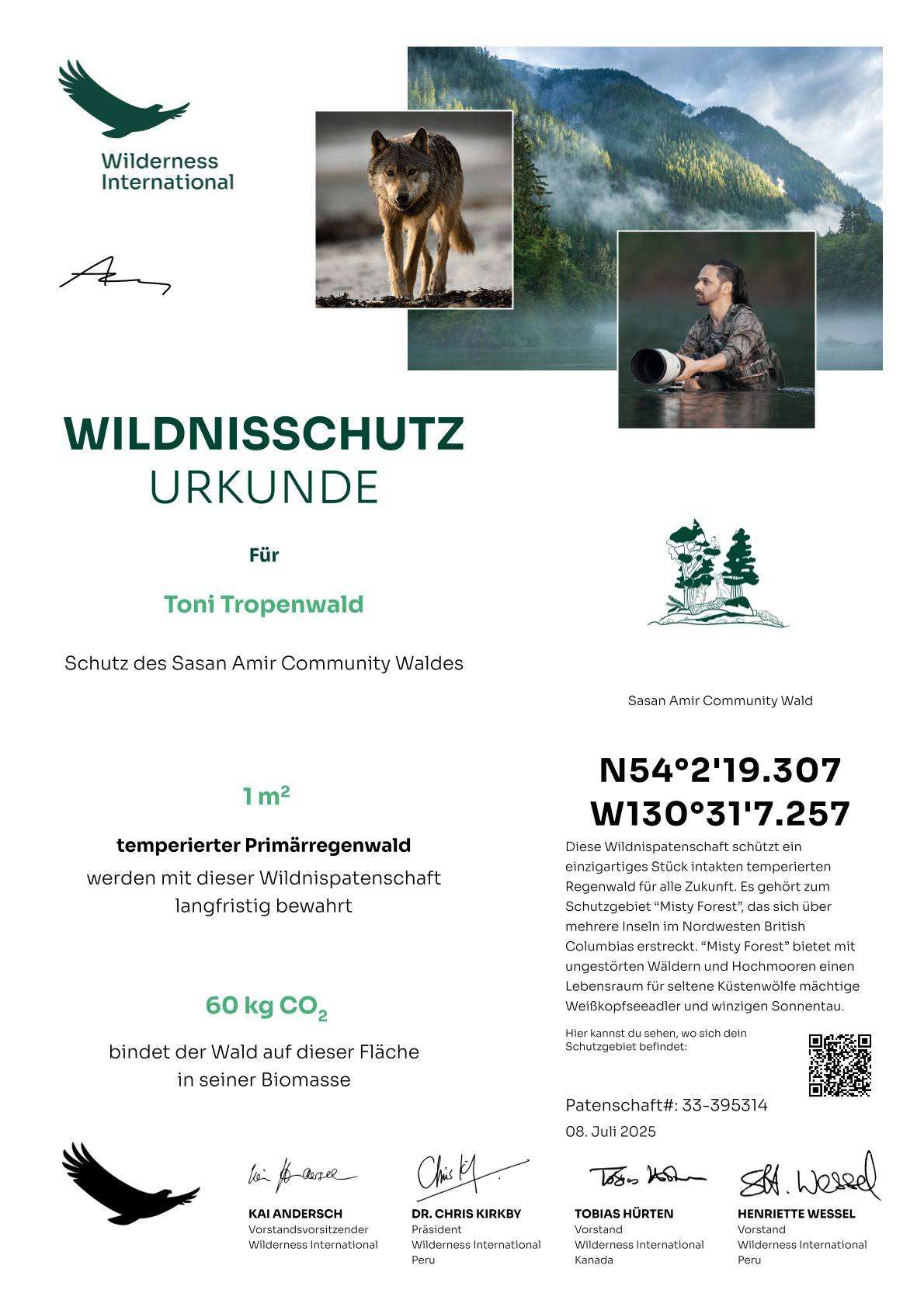Sasan Amir Community Forest
Commitment and passion for nature conservation for more than 20 years
Sasan Amir is an international wildlife photographer and filmmaker who is passionate about protecting and highlighting endangered species and habitats. He has been exploring nature with his camera since childhood and uses his reach and visual language to sensitize people to the beauty and vulnerability of the wilderness.
Join in and protect your piece of the Sasan Amir forest now - for yourself or as a gift!
Donations
of wilderness sponsors have protected
m2 of old-growth forest
tonnes of CO2
remain permanently stored in the biomass of the forest
Together with Wilderness International, I am protecting Canada's last remaining pristine rainforests - habitats where bears, eagles and wolves roam free. These forests are a refuge for countless animal species and a valuable storehouse of carbon and oxygen. By preserving them today, we are safeguarding biodiversity, the climate and the beauty of our planet for future generations.
Sasan Amir
Wildlife photographer & filmmaker
Every contribution counts!
We have a great vision: to protect the last real wilderness areas in our world forever!
To achieve this, we buy ecologically valuable and acutely endangered forest areas by land register entry in order to protect them in a legally secure, permanent and transparent manner. The purchases are refinanced by your donations and protected in the long term.
How you can protect forests:
Select size
Select the size of the forest area you want to protect in the donation form.
Fill in the donation form
Enter your details in the form to ensure that you receive all the information and the donation receipt.
Design certificate
Now you can personalize the certificate with your name or the name of the person you want to give the gift to. If you want, you can also add an occasion.
Receive certificate
You can download the certificate with the geocoordinates of your protected area directly after payment. It will also be sent to you by e-mail, together with a link that shows you your personal protected area on our online map down to the square meter.
Your wilderness protection certificate - also a perfect gift
Immediately after your donation, you will receive a personalized certificate about the piece of wilderness you have protected. It also makes a great gift!
Impressions from the Sasan Amir rainforest
The primeval forests of Western Canada are home to wild coastal wolves, mighty bald eagles, rare carnivorous sundews and gigantic primeval forest giants such as maple trees up to 2,000 years old, Alaskan cedars and western red cedars.

Some trees in the Canadian forests reach heights of over 100 meters.

There is still a healthy grizzly population in the West Coast rainforest.

Resident orcas rely on salmon, which are born in the streams and rivers of the primeval forest, as their main source of food.

The king of the skies - the bald eagle - can reach a wingspan of up to 3 meters.

By donating to us, you are not just protecting an area, but hundreds of cubic meters of habitat.

Canada's humpback whales are returning: After years of protection, humpback whale populations are recovering significantly, especially on the west coast.

Transparent, tested & recommended!
In 2017, we joined the Transparent Civil Society Initiative.
We are committed to high standards of transparency, accountability and effectiveness for international NGOs.
The Phineo "Wirkt!" seal also confirms that our work has a traceable effect and that we are a high-performance and transparent organization. To receive it, we were analyzed by independent experts over a period of six months in a four-stage process.
What is a temperate rainforest?
Wilderness International purchases legally secure wilderness areas and protects them for all future generations. The purchases are refinanced through donations, which at the same time ensure the long-term protection of the areas and enable environmental education projects and research into CO2 storage and biodiversity. Donors receive a personalized certificate with the exact geo-coordinates of the protected forest area, so that the protection is directly traceable. We are currently active in the temperate rainforest of Western Canada and in the Amazon rainforest of Peru, where we are protecting ancient primary rainforests.
There are no further obligations for you. The donation is one-time, and enables us as a foundation to ensure the long-term protection of the area. The sponsorship is a symbolic one. The forest area remains the property of the Foundation.
We protect the areas we select exclusively through purchase with entry in the land register and in countries with a high level of legal security. All three international foundations are registered as owners in the land register. The forest areas that we have purchased as foundations can no longer be bought from us and we are no longer allowed to sell them.
The organizational form of the foundation prevents the rights over the disposal of property from resting with a single person and ensures its permanent existence. Our statutes stipulate that the land is to be left untouched and only visited for research and documentation purposes.
Due to their remoteness and the undeveloped area, our protected areas in Canada can only be reached at great financial, material and time expense and not without risk. In addition, the high level of legal certainty in Canada ensures that damage to land results in severe sanctions. The British Columbia Trespass Act clearly prohibits trespassing on private land. Violations are prosecuted in court, even if no damage has been done. We also visit and inspect the areas as part of regular research visits and have partnerships with local companies that support us.
The rainforests in Peru and Canada are among the last 2.8% of intact wilderness areas on our planet - and are unfortunately under acute threat(Plumptre et al., 2021). 10-15% of all annual emissions are caused by the destruction of these forests and their peatlands, more than by the aviation sector - so we need to act now!
Numerous studies prove the threat to the rainforest in Peru and Canada. In British Columbia, Canada, this is especially true:
- It is home to the last large contiguous area of temperate rainforest in the world (DellaSala, 2010). And yet British Columbia, of all places, is one of the last jurisdictions in the world that continues to allow the large-scale deforestation of 600 to 1,800-year-old primeval forest giants (Wu, 2019).
- Between 2003 and 2010, deforestation in BC was responsible for higher annual CO2 emissions than the country of Finland as a whole (Wieting, 2015). The main causes of this are the timber industry, agriculture and infrastructure construction.
- On the online map of the Ancient Forest Alliance (2016 ) you can see an impressive visualization of how deforestation has progressed in southeastern BC up to 2016.
If we lose the last intact rainforests, this will have catastrophic consequences for our planet. The concept of planetary boundaries states that there are certain ecological limits which, if exceeded, will jeopardize the stability of the Earth's ecosystem and thus the progress of humanity. Numerous studies show that we are well on the way to exceeding at least five of the nine planetary boundaries, also known as 'tipping points' or 'tipping elements'. One of these elements is the loss of the tropical rainforest. We can already feel the consequences of climate change, but we still have the chance to avert the worst effects, as the summary of the book 'Earth for all' shows.
About Wilderness International
The foundation, based in Peru, Canada and Germany, purchases legally secure wilderness areas and protects them for all futures. The purchases are refinanced by donations that ensure the long-term protection of the areas and enable environmental education projects and research on CO2 storage and biodiversity.


non-profit foundation under civil law
Suite 345, 108-4301B Southpark Drive
Stony Plain, AB, T7Z2A9
Canada
Registered Canadian Charitable number: 840904817 RR0001
